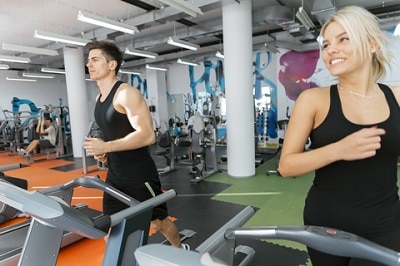Running on a treadmill is an efficient and quick way to train and keep fit by shedding off the extra pounds. But is running on a treadmill bad for your knees? There are two ways to look at this issue, and there can never be one correct answer. Running on a treadmill has its advantages and disadvantages. In this article, we will try to answer this question as we discuss the proper way to run on a treadmill. Read on.
Is Running On a Treadmill Bad For Your Knees?
Most recently, treadmills have become popular owing to their simplicity and convenience. Compared to an elliptical runner, a person running on a treadmill exerts more stress on their knees. There is a proper way to run on a treadmill. For example, running on a higher speed intensifies the pressure on your knees. Consequently, you experience more discomfort and irritation in the knee joint.
Similarly, the flat treadmill surface causes your body to work differently. The proper way to run on a treadmill is at a one-percent incline to simulate real outside running environment. Treadmills require moderation and careful monitoring. Otherwise, you might injure yourself or make your knee injury worse. Other disadvantages include:
Prolonged stress weakens muscles.
Long work-out sessions have proven to bear results almost instantaneously. However, running on the treadmill on end exerts too much pressure on the knee muscles, which creates soreness. Partly because the surface of the treadmill does not resemble the outside surface and the gradient does not change much. Over a long period, you might begin to experience soreness on your knees.
You become less agile compared to running on terrains.
Treadmills cannot simulate the experience of running in real life, as they do not have uneven ground. This gradually reduces a person’s agility on real terrains.
Muscle strains.
Sad to say but treadmills alone account for approximately 24,000 injuries each year. Worse still, a couple of deaths like in the case of the renowned SurveyMonkey CEO David Goldberg who hit his head after falling off a treadmill. It is thus advisable, for your safety, to get the help of a qualified instructor if you are not well acquainted with treadmills.
Limited ancillary benefits.
Treadmills have a flat surface, which makes the body too comfortable. As a result, you might ruin your proprioception ability. Altering surfaces improves coordination between your body parts and the brain. This feature is unavailable with treadmills.

The Proper Way to Run On Treadmill
The above limitations and injuries can be mitigated if you adopt the proper way to run on a treadmill. This includes the following practices:
- Exercise in moderation. Don’t run for long durations on the treadmill to avoid irritating your knee injury. High-Intensity Interval Training (HIIT) is recommended on the treadmill because it is more productive and less strenuous.
- Increase the distance gradually. If you have just begun running on the treadmill start small and then extend the speed and duration gradually. Doing so gives your muscles ample time to adapt.
- Take some time off for muscle and joint recovery. If you begin to experience weariness, it is advisable to take a short break to let your muscles relax and get back to shape. But you shouldn’t quit though!
- Get the appropriate gear. Make sure your work out equipment is as fit as you want to be. Also, remember to change your running shoe at most after every 800 km. This works to prevent your sole from aching due to the impact made on the surface of the treadmill.
- Set your treadmill at an incline position. This will simulate a hill pattern, which in turn makes the work out more productive. A one-percent incline will work just fine for a start. Long and flat runs leave the body in fatigue without much productivity.
- Get checked occasionally. If you have a history of back pain or chronic illnesses, it is advisable to go for routine checkups to prevent further damage to your body.
So is running on a treadmill bad for your knees? No. If you master the proper way to run on a treadmill, you will not experience pain or discomfort. Don’t be like some people who are quick to quit after a few failed lame attempts.
With the current advancement in technology, treadmills have incorporated more features aimed at making your exercise less boring and more comfortable. Invest in a good treadmill, but if you can’t afford one exercise in a well-equipped gym.
Moreover, there are several tutorials offering guidance on how to use a treadmill for beginners. But most importantly, safety should always come first. Just a few mistakes here and there and you will get the hang of it. We always say the first run is never perfect. The goal is to stay fit without compromising your wellbeing. And the secret is never to quit once you start.
In Conclusion
The above-discussed limitations about running on treadmills may make it seem like an unsafe option. They are very safe if you practice the proper way to run on a treadmill. The mistake most runners make is prematurely overworking their muscles, which impedes further exercise. That is why today you are asking the question “is running on a treadmill bad for your knees?” Research has shown that running on treadmills is one of the most efficient methods to train, lose weight, as well as keep fit. Running on a treadmill engages most of your body muscles (including the heart). If done in moderation and adherence to the instructions, running on a treadmill is healthy. Have a happy run.














Thank you for this great post about running on a treadmill. I am currently suffering with bad kness so I am not running at the moment, but usually I run outside. My knee hurts most when I run uphills so I am thinking that using a treadmill with a shallow gradient might be a good way to get back into it. Do you agree? Thanks!
Hi, Chris and thank you.
Number one I would contact your doctor about because there can be so many factors which come in it. For example, I like an elliptical trainer for my knee if I´m bad in it because it is softer. I know too, that some of my friends like more treadmills if they are in problem.
But having said that, yes, I would try it. A one-percent incline will work just fine for a start. Long and flat runs leave the body in fatigue without much productivity.
If I can help you with anything else, or if you have any questions, don´t hesitate to contact me.
Thanks for the informative post. I actually skipped the treadmill machine and went for one of the Bowflex M machines…it’s more of an elliptical setup. I did this mainly due to concerns of the impact a treadmill would have on my knees. It never occurred to me that there would be ways to mitigate such impacts safely.
Do you happen have or know where one might find a good reference for the new treadmill runner that might contain a recommended exercise program? Maybe one that will ramp up the new runner from beginner, slowly and safely?
Thank you again,
Scott
Hi, Scott and thank you.
One of the best things which all these machines is that there are so many possibilities to solve things if people “think outside the box.” For example, how have thought a few years ago that you could even train your arms on a treadmill with “walking” on your arms with the legs on the floor behind the treadmill?
Here is a good guide about starting slowly on treadmills, both for safety reason and building your form up.
If I can help you with anything else, or if you have any questions, don´t hesitate to contact me.
You made some great points. I use the treadmill a lot and haven’t had any problems with my knees or anything else. You made a point that the proper way to run on a treadmill should be done in moderation. Exactly how long is unsafe to run on a treadmill? Is it a certain amount of miles you should stop at? Or is it a certain amount of time that should be the limit?
Hi, Jasmine and thank you.
Thank you for kind words.
About how much you should run depends on how good form you are in and if you are injury free or not. So it is a very much question about each person. On same time it is vital not to overtrain. Not doing more than your body is ready to manage. So the best advice I can give is to listen to your body. If you do, you will be quick in form, steady and steady.
If I can help you with anything else, or if you have any questions, don´t hesitate to contact me.
This is a very interesting and informative post. I have often wondered if running on a treadmill could translate to real life application. I have not ran on a treadmill for a little while, but I have just started back up again. I agree with what you said, the knees are an area that can stressed rather easily. Your explanation for on how running on a flat treadmill makes sense because the human body was not designed to move in one motion. Running outside does allow your body to adjust to uneven terrain.
Hi, Kenny Tang and thank you.
Thank you for kind words.
The most important thing is to listen to your body. If you do, you will get in form soon. But if not it is possible that you need to take some steps back.
If I can help you with anything else, or if you have any questions, don´t hesitate to contact me.